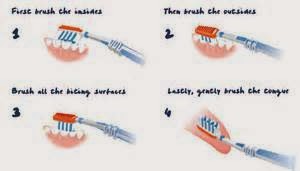Toothbrushing is such an ingrained habit, few
people think twice about it. But as with any habit, you can get sloppy, and
that can lead to cavities and gum disease.

No. 1: Not Using the Right Toothbrush
Consider the size of your mouth when picking a
toothbrush, If you are straining to
open wide enough to let the brush in, the brush is probably too big,.
The handle has to be comfortable ,It should
feel as comfortable as holding a fork when you eat.
The more comfortable it is in your mouth and your
hand, then the more likely you will use it and use it properly,.
Which is the better toothbrush: Electric or
manual?
It's an individual preference, A person who
brushes well with a manual will do as well as a person who brushes well with an
electric.

Price agrees. It's not the toothbrush, it's the
brusher.
No. 2: Not Picking the Right Bristles
Some toothbrushes have angled bristles, others
straight. So is one type better? Dentists say no.
What is important when buying a toothbrush?
Bristles that are too stiff can aggravate the gums. The ADA recommends a
soft-bristled brush.
Bristles should be sturdy enough to remove
plaque but not hard enough to damage [the teeth] when used properly,.
No. 3: Not Brushing Often Enough or Long Enough
Softly brushing your teeth at least twice a day
is recommended. ''Three times a day is best,"

With too much time between brushings, bacterial
plaque will build up, boosting the risk of gum inflammation and other problems.
Brushing should last at least two minutes,
Most people fall short of both time lines, it’s
an arbitrary number, but it's just so people take the time to clean all the
surfaces. Often recommends people divide
the mouth into quadrants and spend 30 seconds a quadrant. Some electric
toothbrushes include built-in timers.
No. 4:
Brushing Too Often or Too Hard
While brushing your teeth three times a day
is ideal, more may not be, "More than four toothbrushings a day would
begin to seem compulsive.
Excessive brushing could expose the root of
the tooth to irritation, and that could in turn irritate the gums. Brushing
vigorously can also erode tooth enamel. The trick is to brush very gently for
two to three minutes.
No. 5: Not Brushing Correctly
Long horizontal strokes along the gumline can
lead to abrasions, Aim your bristles at the gum line at a 45-degree angle and do
short strokes or vibrations. Softly brush up and down your teeth, not across
your teeth. The strokes should be vertical or circular, not horizontal.
 Be sure to brush outer and inner tooth surfaces,
the chewing surfaces, and your tongue.
Be sure to brush outer and inner tooth surfaces,
the chewing surfaces, and your tongue.
No. 6: Starting in the Same Place Each Time
Many people start brushing the same part of
their mouth over and over, dentists find.
Start in a different place so that you don't get
lazy in the same area of your mouth, that by the time you get to the last
quadrant of your mouth, you're bored with brushing.
No. 7: Skipping Inner Tooth Surfaces
Most people forget to brush the inner surfaces
of teeth -- the surface that your tongue presses against.
The plaque you can't see is just as important to
remove as the plaque you can see.
The most commonly skipped area, dentists say, is
the inner surface of the lower front teeth.

Bacteria can grow on an un-rinsed toothbrush.
Then, the next time you brush your teeth, you may actually put old bacteria
back in your mouth.
Rinsing the toothbrush after you brush will help
remove any leftover toothpaste, too.
No. 9: Not Letting the Toothbrush Dry
If you have a toothbrush that's perpetually
moist, it will cultivate more bacteria.

If the bristles stay soggy, you can misshape
them as you use the brush, Or it might be a breeding ground for bacteria."
It's a good idea to shake out the moisture, then
recap it with a cap that allows air in.
No. 10: Not Changing the Toothbrush Often Enough
 The American Dental Association recommends
getting a new brush every three or four months, or even sooner if the bristles
look frayed.
The American Dental Association recommends
getting a new brush every three or four months, or even sooner if the bristles
look frayed.
But rather than go by a strict timeline. . Once
the bristles lose their normal flexibility and start to break apart, change
your toothbrush..
Look more at the state of the bristles than the
time period.
Some brushes have colored indicators that alert you when they need
replacing.
Excessive brushing could expose the root of the tooth to
irritation, and that could in turn irritate the gums. Brushing vigorously can
also erode tooth enamel. The trick is to brush very gently for two to three
minutes




































